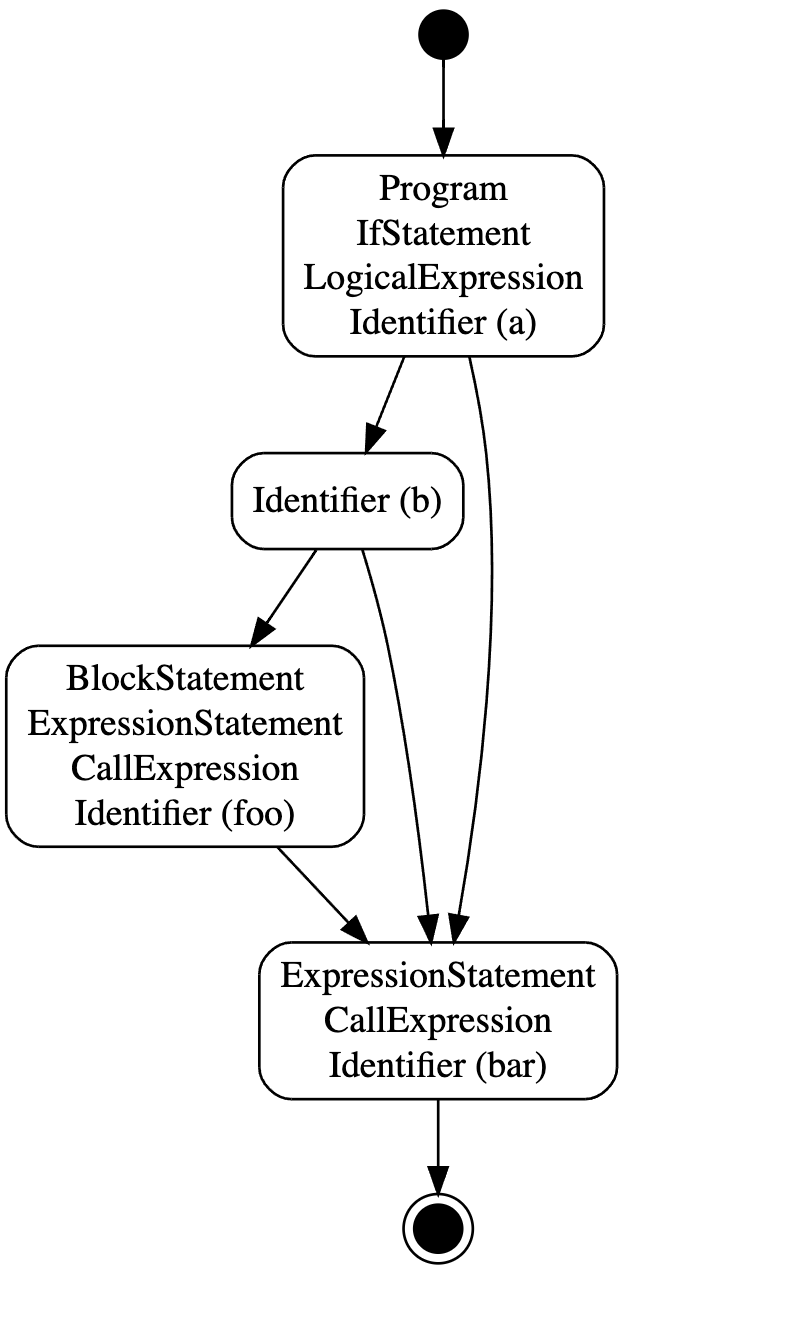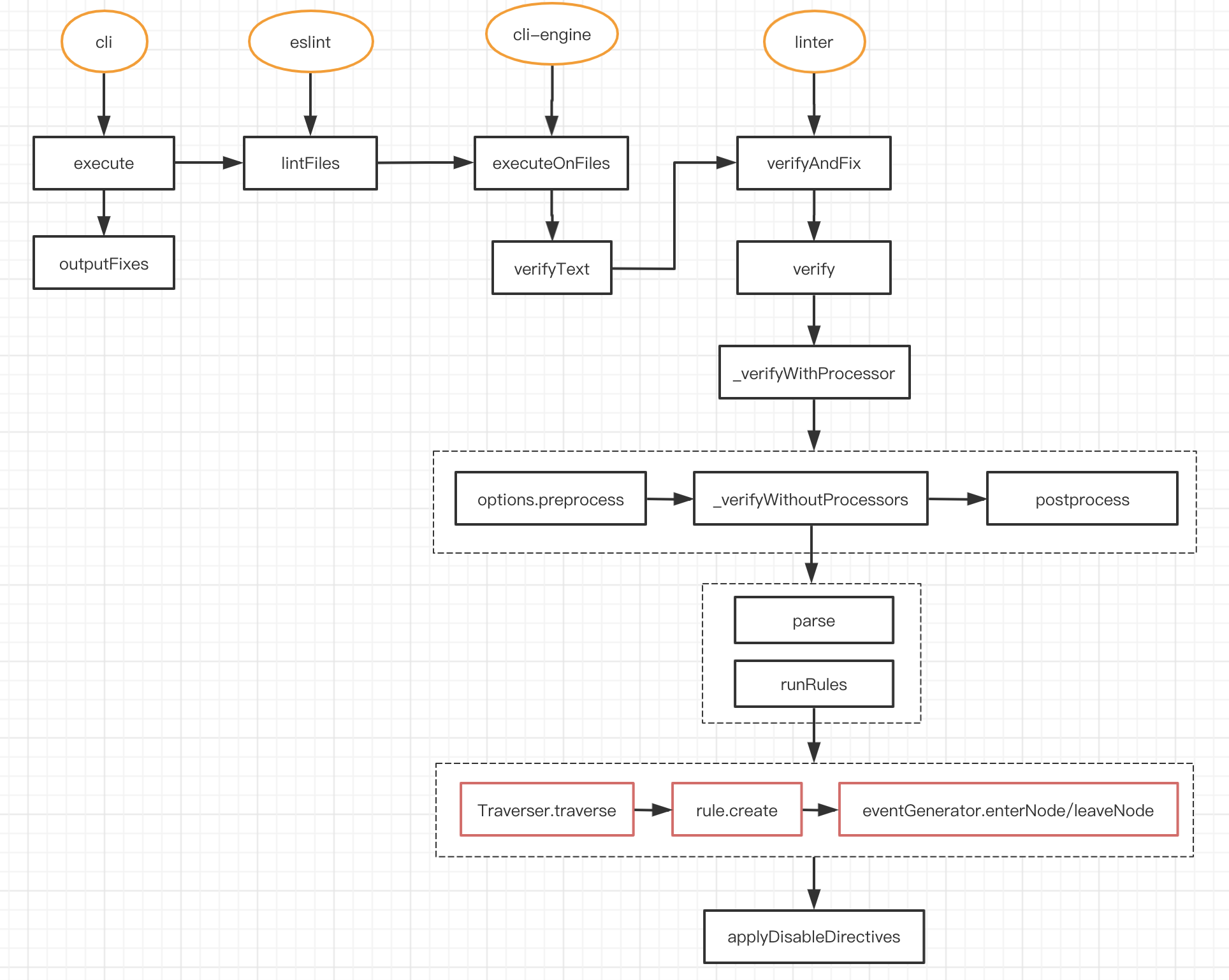# 一、开始
Eslint 是日常工作中不可少的代码检测工具,本文简单介绍几个核心概念和 Eslint 的工作原理。Eslint 的官方文档写的比较详细,建议先阅读其文档后再读本文。
# 二、核心概念
Eslint 的核心概念包括Rule、plugin等。
# 1. Rule
关于规则官方文档 (opens new window)介绍的很详细。Eslint 官方的rules在lib/rules目录下,看一个具体的rule——no-var (opens new window)。
no-var规则就是禁止使用var声明变量,而是用let或const。下面是它的的代码。
可以看到它是一个对象,其包含meta对象和create函数。meta对象即为它的元信息,create函数则是rule运行时的方法。当检测到错误时,会调用context.report抛出错误,它的参数中包含一个fix方法,就是修复函数。
module.exports = {
meta: {
type: "suggestion",
docs: {
description: "require `let` or `const` instead of `var`",
recommended: false,
url: "https://eslint.org/docs/rules/no-var"
},
schema: [],
fixable: "code",
messages: {
unexpectedVar: "Unexpected var, use let or const instead."
}
},
create(context) {
const sourceCode = context.getSourceCode();
function hasSelfReferenceInTDZ(declarator) {
if (!declarator.init) {
return false;
}
const variables = context.getDeclaredVariables(declarator);
return variables.some(hasReferenceInTDZ(declarator.init));
}
function canFix(node) {
const variables = context.getDeclaredVariables(node);
const scopeNode = getScopeNode(node);
if (node.parent.type === "SwitchCase" ||
node.declarations.some(hasSelfReferenceInTDZ) ||
variables.some(isGlobal) ||
variables.some(isRedeclared) ||
variables.some(isUsedFromOutsideOf(scopeNode)) ||
variables.some(hasNameDisallowedForLetDeclarations)
) {
return false;
}
if (astUtils.isInLoop(node)) {
if (variables.some(isReferencedInClosure)) {
return false;
}
if (!isLoopAssignee(node) && !isDeclarationInitialized(node)) {
return false;
}
}
if (
!isLoopAssignee(node) &&
!(node.parent.type === "ForStatement" && node.parent.init === node) &&
!astUtils.STATEMENT_LIST_PARENTS.has(node.parent.type)
) {
// If the declaration is not in a block, e.g. `if (foo) var bar = 1;`, then it can't be fixed.
return false;
}
return true;
}
/**
* Reports a given variable declaration node.
* @param {ASTNode} node A variable declaration node to report.
* @returns {void}
*/
function report(node) {
context.report({
node,
messageId: "unexpectedVar",
fix(fixer) {
const varToken = sourceCode.getFirstToken(node, { filter: t => t.value === "var" });
return canFix(node)
? fixer.replaceText(varToken, "let")
: null;
}
});
}
return {
"VariableDeclaration:exit"(node) {
if (node.kind === "var") {
report(node);
}
}
};
}
};
Rule 是 Eslint 的重要组成部分,有时间的话可以多看下其他 Rule 是怎样实现的。
# 2. Plugin
插件可以看作是第三方规则的集合,每个插件是一个命名格式为 eslint-plugin-<plugin-name> 的npm模块,看下eslint-plugin-vue的实现。
它包含了
rules,一系列规则configs,为插件提供不同的配置,我们可以这样使用extends:['plugin:vue/recommended'],也就是使用其中一个configprocessors,为.vue文件提供特殊的处理方法environments,声明额外的环境
module.exports = {
rules: {
'array-bracket-newline': require('./rules/array-bracket-newline'),
'array-bracket-spacing': require('./rules/array-bracket-spacing'),
// ...
},
configs: {
base: require('./configs/base'),
essential: require('./configs/essential'),
'no-layout-rules': require('./configs/no-layout-rules'),
recommended: require('./configs/recommended'),
'strongly-recommended': require('./configs/strongly-recommended'),
'vue3-essential': require('./configs/vue3-essential'),
'vue3-recommended': require('./configs/vue3-recommended'),
'vue3-strongly-recommended': require('./configs/vue3-strongly-recommended')
},
processors: {
'.vue': require('./processor')
},
environments: {
'setup-compiler-macros': {
globals: {
defineProps: 'readonly',
defineEmits: 'readonly',
defineExpose: 'readonly',
withDefaults: 'readonly'
}
}
}
}
# 3. extends
extends是 Eslint 的一个配置项,它支持的类型有:
eslint:recommended、eslint:all,Eslint 的默认配置- 可共享配置的名称,以
eslint-config-开头,比如eslint-config-standard - 插件,比如
plugin:vue-plugin-react/recommended,或者省略vue-plugin-,即plugin:react/recommended - 配置文件的路径,比如
./node_modules/coding-standard/eslintDefaults.js
extents中的每一项内容最终都指向了一个和 ESLint 本身配置规则相同的对象。
# 4. CodePath
Rule不仅可以针对每个Node.type写规则,还可以针对onCodePathStart/onCodePathEnd做相应的判断,涉及到的一个概念就是CodePath。CodePath就是对代码结构做一定的拆分,在一些较为复杂的Rule中,只判断Node.type较为困难,这时可以对codepath判断。
下面是官网的一个例子:
if (a && b) {
foo();
}
bar();

上图可以看作一个大的CodePath,可以分为5段,每段称为CodePathSegment。
下面是CodePath的运用案例:
检查代码是否可达:
function isReachable(segment) {
return segment.reachable;
}
module.exports = function(context) {
var codePathStack = [];
return {
// Stores CodePath objects.
"onCodePathStart": function(codePath) {
codePathStack.push(codePath);
},
"onCodePathEnd": function(codePath) {
codePathStack.pop();
},
// Checks reachable or not.
"ExpressionStatement": function(node) {
var codePath = codePathStack[codePathStack.length - 1];
// Checks the current code path segments.
if (!codePath.currentSegments.some(isReachable)) {
context.report({message: "Unreachable!", node: node});
}
}
};
};
# 三、运行机制
# 1. 总体

直接看流程图就可以了,注意eslint-disable-line这种在行内注释来忽略规则的处理,会在applyDisableDirectives (opens new window)中执行。
# 2. runRules
runRules (opens new window)是比较重要的内容,下面分析下其过程。
function runRules(sourceCode, configuredRules, ruleMapper, parserName, languageOptions, settings, filename, disableFixes, cwd, physicalFilename) {
const emitter = createEmitter();
const nodeQueue = [];
let currentNode = sourceCode.ast;
Traverser.traverse(sourceCode.ast, {
enter(node, parent) {
node.parent = parent;
nodeQueue.push({ isEntering: true, node });
},
leave(node) {
nodeQueue.push({ isEntering: false, node });
},
visitorKeys: sourceCode.visitorKeys
});
/*
* Create a frozen object with the ruleContext properties and methods that are shared by all rules.
* All rule contexts will inherit from this object. This avoids the performance penalty of copying all the
* properties once for each rule.
*/
const sharedTraversalContext = Object.freeze(
Object.assign(
Object.create(BASE_TRAVERSAL_CONTEXT),
{
getAncestors: () => getAncestors(currentNode),
getDeclaredVariables: sourceCode.scopeManager.getDeclaredVariables.bind(sourceCode.scopeManager),
getCwd: () => cwd,
getFilename: () => filename,
getPhysicalFilename: () => physicalFilename || filename,
getScope: () => getScope(sourceCode.scopeManager, currentNode),
getSourceCode: () => sourceCode,
markVariableAsUsed: name => markVariableAsUsed(sourceCode.scopeManager, currentNode, languageOptions, name),
parserOptions: {
...languageOptions.parserOptions
},
parserPath: parserName,
languageOptions,
parserServices: sourceCode.parserServices,
settings
}
)
);
const lintingProblems = [];
Object.keys(configuredRules).forEach(ruleId => {
const severity = ConfigOps.getRuleSeverity(configuredRules[ruleId]);
// not load disabled rules
if (severity === 0) {
return;
}
const rule = ruleMapper(ruleId);
if (!rule) {
lintingProblems.push(createLintingProblem({ ruleId }));
return;
}
const messageIds = rule.meta && rule.meta.messages;
let reportTranslator = null;
const ruleContext = Object.freeze(
Object.assign(
Object.create(sharedTraversalContext),
{
id: ruleId,
options: getRuleOptions(configuredRules[ruleId]),
report(...args) {
/*
* Create a report translator lazily.
* In a vast majority of cases, any given rule reports zero errors on a given
* piece of code. Creating a translator lazily avoids the performance cost of
* creating a new translator function for each rule that usually doesn't get
* called.
*
* Using lazy report translators improves end-to-end performance by about 3%
* with Node 8.4.0.
*/
if (reportTranslator === null) {
reportTranslator = createReportTranslator({
ruleId,
severity,
sourceCode,
messageIds,
disableFixes
});
}
const problem = reportTranslator(...args);
if (problem.fix && !(rule.meta && rule.meta.fixable)) {
throw new Error("Fixable rules must set the `meta.fixable` property to \"code\" or \"whitespace\".");
}
if (problem.suggestions && !(rule.meta && rule.meta.hasSuggestions === true)) {
if (rule.meta && rule.meta.docs && typeof rule.meta.docs.suggestion !== "undefined") {
// Encourage migration from the former property name.
throw new Error("Rules with suggestions must set the `meta.hasSuggestions` property to `true`. `meta.docs.suggestion` is ignored by ESLint.");
}
throw new Error("Rules with suggestions must set the `meta.hasSuggestions` property to `true`.");
}
lintingProblems.push(problem);
}
}
)
);
const ruleListeners = createRuleListeners(rule, ruleContext);
/**
* Include `ruleId` in error logs
* @param {Function} ruleListener A rule method that listens for a node.
* @returns {Function} ruleListener wrapped in error handler
*/
function addRuleErrorHandler(ruleListener) {
return function ruleErrorHandler(...listenerArgs) {
try {
return ruleListener(...listenerArgs);
} catch (e) {
e.ruleId = ruleId;
throw e;
}
};
}
// add all the selectors from the rule as listeners
Object.keys(ruleListeners).forEach(selector => {
const ruleListener = timing.enabled
? timing.time(ruleId, ruleListeners[selector])
: ruleListeners[selector];
emitter.on(
selector,
addRuleErrorHandler(ruleListener)
);
});
});
// only run code path analyzer if the top level node is "Program", skip otherwise
const eventGenerator = nodeQueue[0].node.type === "Program"
? new CodePathAnalyzer(new NodeEventGenerator(emitter, { visitorKeys: sourceCode.visitorKeys, fallback: Traverser.getKeys }))
: new NodeEventGenerator(emitter, { visitorKeys: sourceCode.visitorKeys, fallback: Traverser.getKeys });
nodeQueue.forEach(traversalInfo => {
currentNode = traversalInfo.node;
try {
if (traversalInfo.isEntering) {
eventGenerator.enterNode(currentNode);
} else {
eventGenerator.leaveNode(currentNode);
}
} catch (err) {
err.currentNode = currentNode;
throw err;
}
});
return lintingProblems;
}
- 利用
Traverser.traverse对sourceCode.ast进行递归遍历,将node放进nodeQueue中。nodeQueue是一个队列,一个node会被放入两次,一次是进入的时候,一次是离开的时候,结构类似:A->B-C->...->C->B-A。 - 新建
sharedTraversalContext,是rule的通用的上下文对象。 - 遍历
configuredRules,对每一个rule创建ruleContext,ruleContext上包含report方法,report方法运行时会收集错误到lintingProblems中。 - 对每一个
rule,执行它的create方法,得到返回值ruleListeners,其key是node节点,value是回调函数。对ruleListeners进行遍历,利用发布订阅模式,将node节点和对应的回调函数收集到emitter中。 - 遍历
nodeQueue,触发emitter的emit,也就是执行node节点上的回调。 - 返回
lintingProblems。
runRules利用了发布订阅模式、访问器模式,用一句话总结就是,一开始是收集代码中的node,然后收集rule的回调,最后遍历node,执行回调。
# 四、相关资料
← Eslint配置一劳永逸 V8引擎 →